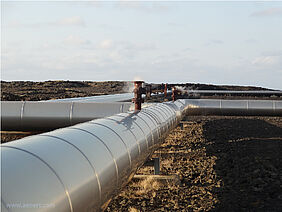Ormat is a leading company that is engaged in the geothermal and recovered energy power businesses. The company is also expanding into different energy storage services and solar photovoltaic (PV), including hybrid geothermal and solar PV, as well as energy storage plus solar PV. Ormat designs, develops, builds, sells, owns, and operates geothermal and recovered energy-based power plants. Ormat owns and operates 25 geothermal, REG and solar sites, globally, with an aggregate generating capacity of 932 MW compared to 914 MW in 2019. Geothermal comprises 94% of generating capacity. In 2020, geothermal and REG power plants generated at a capacity factor of 87% and 74%, respectively, which is much higher than typical capacity factors for wind and solar producers, which are usually at 20% to 30%.
The company conducts business activities in three business segments: electricity segment, product segment, and energy storage. The three business segments contributed 76.8% (72.4% in 2019), 21% (25.6% in 2019) and 2.2% (2% in 2019) of the total revenues in 2020, respectively. In 2019, Ormat delivered 63.1% (61.8% in 2019) of electricity segment revenues from operations in the U.S. and 36.9% (38.2% in 2019) from the rest of the world. 3.9% (16% in 2019) of product segment revenues derived from the USA and 96.1% (84% in 2019) from the rest of the world.
According to the Company´s Annual Report, total revenue decreased by 5.5% from $746.0 million in 2019 to $705.3 million in 2020. This decrease was attributable to a $42.9 million or 22% decrease in product segment revenues, compared to the corresponding period in 2019.
In 2020 and 2019, consolidated power plants generated 6,043,993 MWh and 6,238,272 MWh, respectively, decreased by 3.1%.
Net income attributable to the Company’s stockholders in 2020 was $85.5 million, compared to $88.1 million in 2019, which represents a decrease of $2.6 million. This decrease was attributable to a $10.9 million in net income attributable to non-controlling interest, which increased mainly due to the business interruption recovery of the Puna power plant in Hawaii. Net income in 2020 was $101.8 million, compared to $93.5 million in 2019 and $110.1 million in 2018.
Adjusted EBITDA in 2020 was $420.2 million, compared to $384.3 million in 2019, $368.0 million in 2018 and $343.8 million in 2017.
Research and development expenses in 2020 were $5.4 million, compared to $4.6 million in 2019. The increase is mainly due to new development projects that took place during 2020.
Total cost of revenues for the year 2020 was $429.1 million, compared to $476.7 million for the year 2019, which represented a 10.0% decrease. This decrease was attributable to a decrease of $12.8 million, or 4.1%, in cost of revenues from the electricity segment, a decrease of $31.0 million, or 21.3%, in cost of revenues from the product segment and a decrease of $3.9 million, or 21.5%, in cost of revenues from the energy storage segment. As a percentage of total revenues, total cost of revenues in 2020 decreased to 60.8% from 63.9% in 2019.
Electricity segment revenues were $541.4 million in 2020 compared to $540.3 million in 2019, an increase of 0.2%.
Product segment revenues were $148.1 million in 2020, compared to $191.0 million in 2019, a decrease of 22.5%. The decrease in product segment revenues was mainly due to projects in Turkey and the U.S., which were completed in 2019 and accounted for $75.9 million in revenues in 2019. The overall decrease in product revenues is also attributable to the impact of COVID-19 which resulted in delays in the progress of the third-party projects, as well as a reluctance of potential customers to enter into new commitments.
Energy storage segment revenues were $15.8 million in 2020, compared to $14.7 million in 2019, an increase of 7.6%. The increase was mainly driven by $4.8 million of revenues from the acquisition of the Pomona energy storage asset, as well as the commissioning of Rabitt Hill in Texas.
In 2020, 2019 and 2018, the geographic breakdown of revenues indicated 49%, 49% and 54% of revenues derived from international operations for all 3 segments, respectively, and international operations were more profitable than U.S. operations in each of those years. A substantial portion of international revenues came from Kenya and Turkey and, to a lesser extent, from Honduras, Guadeloupe, Guatemala and other countries. Operations in Kenya contributed disproportionately to gross profit and net income.
The company is focused on further developing a portfolio of geothermal, energy storage, solar (PV) and recovered energy assets and continuing its leading position in the geothermal energy market with the objective of becoming a leading global provider of renewable energy.
